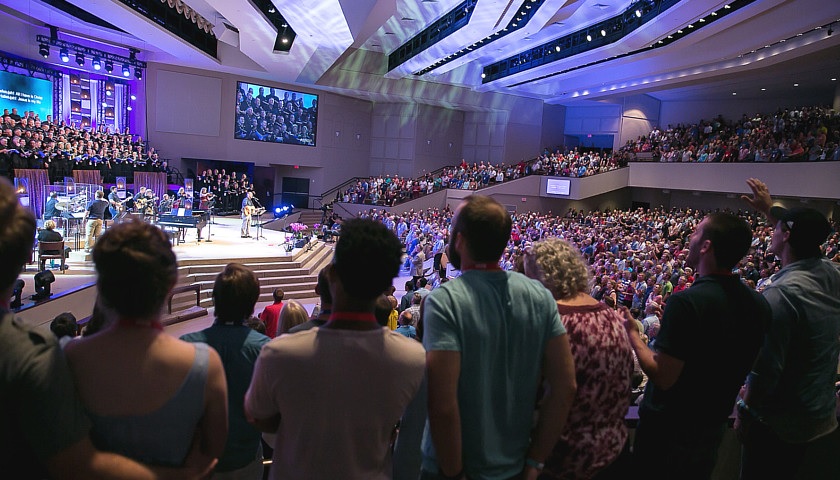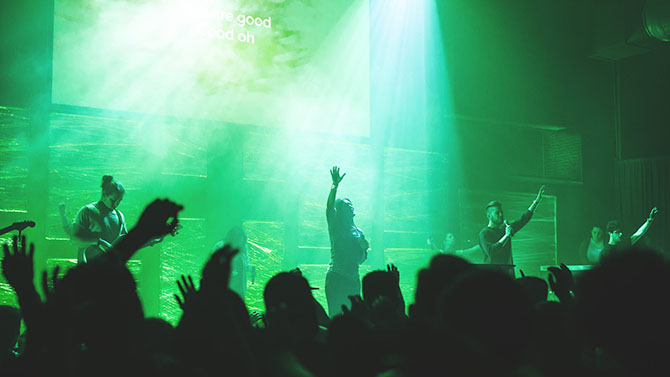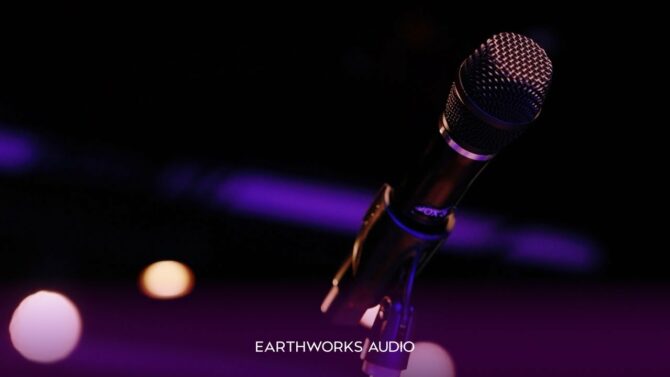Whether for small-to-large venues, outdoor concerts, large auditoriums, or conferences, the sound system’s goal is for everyone to be able to hear at a comfortable level, with clarity and intelligibility. Houses of Worship are a particular challenge, often because of the space itself—depending on where you sit in the sanctuary, it may be too loud or not loud enough. If “Faith comes by Hearing,” then it follows that churches need to place a high priority on the sound system so that everyone can hear the messages of sermons and songs.
ROOM FOR IMPROVEMENT
Let’s analyze some of the issues involving the room itself.
- Size. The room’s size directly impacts the reproduction of certain frequencies. This may seem odd until you consider the physical length of audio waves at various frequencies. When a room’s width or length correlates directly to the length of a waveform
 Definition:
Definition:
A graphic picture of a wave. at a specific frequency Definition:
Definition:
A value, expressed in Hertz, that indicates how many cycles of a periodic signal occur in one second. , a standing wave Definition:
Definition:
A wave subject to reinforcement or cancellation by its reflections. can occur where the initial sound and the reflected sound can either reinforce or cancel each other. This can be exacerbated by the room’s reflectivity. - The number of speakers needed to cover the entire audience. One speaker in the front works for the first rows, but what about those in the rear?
- The construction materials. Low-frequency waves can be powerful enough to cause the walls, ceiling, and even the floor, to flex and move. This is called diaphragmatic action, and it dissipates energy and strips away the low-end definition. So, if your room’s walls and floor are made of solid brick and concrete that don’t vibrate much, the bass response will be much more powerful than if the room’s walls use standard sheet rock construction and the floors are hardwood.
- Sonic reflectivity. Rooms also interact with sound waves through reflectivity. Like most room anomalies, reflections can be good and bad. Consider the effect
 Definition:
Definition:
A device or software program that modifies some aspect of audio or video. With audio, the term is used interchangeably with signal processor. of a cathedral’s reflections on a choir or a piano—this type of reverberation (reverb Definition:
Definition:
Short for Reverberation. The myriad echoes of decaying amplitude created in an acoustic environment. Reverberation may be simulated electronically, mechanically using springs or a metal plate, or in a specially built physical chamber with reflective surfaces where a speaker sends audio into the chamber, and a microphone picks up the reflections.) is quite desirable for recording and acoustic listening, so much so that studios often have “Cathedral” presets in artificial reverbs. However, reproducing audio at normal stage volumes is a different matter. With a speaker near a reflective surface (such as a brick wall or window), the direct sound Definition:
Definition:
1. Sound arriving directly from the source, not reflections. 2. When spelled DirectSound, a mostly obsolete native Windows audio driver. coming from the speaker and the reflected sound coming from the reflective surface can arrive at the listener’s ears out of phase Definition:
Definition:
Sound waves are variations in air pressure that, like water waves, have peaks and troughs. Phase is the waveform's position in its current cycle. For example, if two versions of the same waveform are both at their peak, or at their trough, they're considered in phase. If one is at its peak and one is at its trough, they are considered out of phase. If one is at its peak and the other is at zero (between the peak and trough), then the two waveforms are 90 degrees out of phase. See also: Polarity with each other, causing cancellation and/or reinforcement. When setting up loudspeakers in a reverberant space, position the speakers to focus the sound on the middle of the room, and aim away from reflective surfaces. Installing acoustic treatment Definition:
Definition:
The process of using absorption, diffusion, and other techniques to modify a room's acoustic characteristics, typically to obtain a flatter response. on the walls will also lessen the impact of reflections.
ARE MORE SPEAKERS THE ANSWER?
Yes...and no, unless they’re done right. Many churches use a pair of speakers on walls (or stands) toward the front of the space to fill the left and right sides of the room with sound. But if you sit up front, while the kids may be enjoying it, elderly churchgoers may be ripping out their hearing aids.
Meanwhile, those in the back may not be able to differentiate between the vowels and consonants, and others may not be able to discern anything at all. Unless the room is small, one or two loudspeakers will not do the job of covering the audience (Fig. 1).

I’ve been to many churches where they’ve recognized this problem, so they installed additional speakers to cover more area. However, they made the crucial mistake of not delaying the signal going to the additional speakers. Here’s why this is essential.
Sound travels at approximately 1,130 feet per second, or 1.13 feet per millisecond. The speed of light is 186,000 miles/second. That’s why you see lightning first and only hear the thunder later. (Fun fact: Next time you see lightning, start to count out the seconds—one, one thousand, two, one thousand, three, one thousand, etc., until you hear the thunder’s rumble. If you get to five, the lightning strike was about a mile away—5,000 feet.)
Got it? Now, suppose you’re sitting toward the back of a church that has loudspeakers placed in the front, and non-delayed loudspeakers placed 50 feet toward the back, or under the balcony. If the speakers play back the same audio at exactly the same time and you’re sitting toward the back, you’ll hear the sound twice: once immediately from the speakers that are closest to you, and then about 50 milliseconds later from the main system’s loudspeakers. While this doesn’t sound quite as specific as an echo Definition:
Definition:
A repeat of an audio signal., it’s certainly enough for you to know that something is not rriigghhtt. Delaying the speaker(s) in the rear of the church by 50 milliseconds removes the echo and improves the system’s intelligibility (Fig. 2).

Another benefit is that using two (or if needed, more) speakers will reduce the levels in each area, front and back, to provide a more comfortable listening level.
LET’S TALK SOLUTIONS
There are expensive tools and software that professionals will use to time-align, calibrate, and “tune” the speakers to the room. For difficult spaces, it may be a good idea to bring someone in to evaluate your sanctuary.
On the other hand, you can determine the amount of delay Definition:
Definition:
A device that outputs and input signal some time later. This can be short for echo effects, longer for matching speaker stacks, or aligning sound and video. each additional speaker will need with a tape measure and a calculator. If you have a speaker under a balcony, measure the distance from the main speaker to it. Multiply the distance times 1.1 milliseconds. This is the amount of delay you need to add.
Many digital Definition:
Definition:
A signal or data expressed as series of the digits 0 and 1, typically represented by values of a physical quantity such as voltage or magnetic polarization. consoles, like the PreSonus StudioLive-32 and StudioLive-24, include delay on every output, aux bus Definition:
Definition:
1. In audio, a common point that combines multiple signals, as in a "mix bus." 2. In computers, a path that interconnects various elements for transferring data among those elements., subgroup Definition:
Definition:
A number of mixer channels that can be controlled together, as if they were one channel. Also called Group or Submix., and matrix Definition:
Definition:
1. (mixers) A crosspoint of controls for creating different mixes simultaneously. 2.(video) A crosspoint for switching a number of video input signals to different outputs. Also called Audio Follow Video Matrix. so you don’t need to purchase additional hardware. So, apply the appropriate amount of delay to the output that feeds your under-balcony speaker, or the front fills, or the side fills, or the foyer. The Foyer? Absolutely! Have you ever been in your church’s lobby, having a cup of coffee while you’re waiting for your infant to stop crying, watching the LED Definition:
Definition:
LED (Light-Emitting Diode): A semiconductor light generator used in displays, television, pointers and for general illumination. It is a low-power replacement for incandescent lamps. screen so as not to miss the service? Notice anything different about the sound? You see/hear the band and depending on how far away you are from the main stage, you may hear the kick drum twice, once from the foyer speaker and again maybe 100 milliseconds later through the walls. If this isn’t the case, the foyer speakers have probably been set up properly, and the walls have been constructed with the right material to mitigate the room sound.
Many loudspeakers incorporate adjustable delays in their internal DSP Definition:
Definition:
1. DSP (Digital Signal Processor): An integrated circuit or device that mathematically alters sound or video signals. 2. DSP (Digital Signal Processing): The technique of converting an analog signal into digital data, manipulating that data, then producing an analog output that reflects the changes caused by these manipulations done in the digital domain.. The PreSonus StudioLive AI Definition:
Definition:
AI (Artificial Intelligence): The use of a computer to simulate human thought processes in solving problems or analyzing data. series powered speakers also include an app (Fig. 3) that provides remote Definition:
Definition:
A broadcast from the field, not from the studio. A Remote Control. control over the speaker’s internal delay, so you can tweak Definition:
Definition:
1. To make minor adjustments. 2. A person who is a perfectionist. the timing while moving around the room.

If you have an analog Definition:
Definition:
A signal that is continuous in nature, as opposed to being defined as a series of discrete numbers (or elements) as found in digital signals; electrically "analogous" to an acoustical signal in the air. board Definition:
Definition:
A Sound or Lighting Control Console. and the speakers do not have this feature, you’ll need to buy a simple delay device like the Rane AD22S, and patch it between the console’s output and the loudspeaker.
SETTING LEVELS
Our next task is making sure the levels are correct for all the loudspeakers in the room. Once you’ve positioned and delayed your satellite system, use an SPL Definition:
Definition:
See Sound Pressure Level. meter to match the output of the main and delay systems at the measurement point. For example, if you are standing 30 feet from the left side of the main system and 10 feet from the left side of the delay system, and the output of the main system is 85 dB Definition:
Definition:
1. A deciBel is a logarithmic ratio between two quantities, and is a nonlinear measurement that mimics human perception. 2. A unit expressing sound levels relative to a nominal level just audible by the average human ear, and equal to 1/10th of a Bel. 3. (slang) Database., then the output of the delay system should also be 85 dB (Fig. 4).

Note that frequencies in a delay system’s sub-bass range don’t require distribution. In fact, because low frequencies become omnidirectional Definition:
Definition:
A pattern describing a microphone, radio antenna, or loudspeaker that radiates or picks up in all directions equally., set the system’s highpass filter Definition:
Definition:
1. (audio) A circuit that reduces certain frequencies, e.g., a low-pass or high-pass filter for audio. See also: Equalizer. 2. (optics) reduces certain color wavelengths or polarizations. around 300 to 400 Hz Definition:
Definition:
Abbreviation for Hertz. Unit of measurement for frequency, formerly called CPS (Cycles Per Second), that measures periodic waves, audio and radio frequencies, and mechanical repetitive motion. Example: 1000 Hz means a periodic waveform has 1000 cycles/vibrations per second. to avoid sound going back toward the stage. You may even want to go one step further and create a specific delay speaker mix, that enhances vocals and rolls off the lower frequency instruments.
The general rule of thumb is to place delay systems where the main system’s intelligibility falls apart, as it’s overcome by environmental obstacles:
Inside. Indoors, you’re trying to overcome the direct-to-reverberant reflections. Your goal is to find where the direct signal-to-reverberation ratio has reached about 50/50. At this point, the reflections in the room are at an equal level to the direct sound of the P.A., which impacts vocal intelligibility.
Outside. Outdoors, the goal is to maintain level as the noise floor Definition:
Definition:
The unalterable, lowest noise level within a system, measured in dB. For example, microphone preamp hiss might set the noise floor in a recording situation. of the crowd begins to be at equal level to the P.A. in the intelligibility range. At this point, the main system needs more support in order to deliver the same perceived loudness Definition:
Definition:
1. An audio signal's perceived volume. 2. The quantifying of the ear's non-linear frequency response versus volume. See: Fletcher-Munson curve. as you get further from the source.
Finally, if applicable, don’t forget to delay your subwoofers compared to the main speakers. Place your speakers correctly, add the right amount of d e l a y, and your audience or congregation will hear what they’re supposed to hear.












